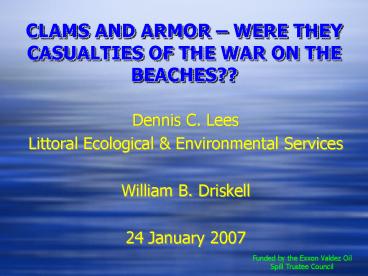CLAMS AND ARMOR PowerPoint PPT Presentation
1 / 31
Title: CLAMS AND ARMOR
1
CLAMS AND ARMOR WERE THEY CASUALTIES OF THE WAR
ON THE BEACHES??
- Dennis C. Lees
- Littoral Ecological Environmental Services
- William B. Driskell
- 24 January 2007
Funded by the Exxon Valdez Oil Spill Trustee
Council
2
ADMIRAL WANTS TO WATER BLAST OILED BEACHES!!!
Adm. Paul Yost, U. S. Coast Guard, calls for
massive, high-pressure, hot-water blasting of the
beaches, even if it kills everything!! Im
here to fight a war!! In contrast, scientists
said there is little scientific knowledge on what
happens when hot water is used to clean shores
like those of the Sound. Anchorage Daily News
(4/15/1989)
3
So We Assaulted the Beaches
4
- Short History
- NOAA Shoreline Treatment Effects Study - 1990-96
- Infaunal data from geographically limited studies
indicated negative effects at Treated sites - Sediment Effects
- Impoverished infaunal assemblages, esp.
long-lived clams - Time-series data suggested recovery was very slow
- Objectives of the present study
- Assess persistence and generality of depressed
condition of clam assemblages in mixed-soft
sediments at Treated sites. - Assess relationship between sediment
characteristics and depressed condition of clam
assemblages in mixed-soft sediments.
5
Alternative Hypotheses
- Sediments -- Concentrations of fines and organic
matter are depressed at Treated sites. - N, S, and H -- Higher at Reference sites.
- Short-lived, nestling, pioneering species -- More
at Treated sites in infaunal samples. - All large clams -- Fewer at Treated sites
6
Sampling Design Methods
- 40 sites - 36 Random 4 Historic Sites
- 16 Oiled but Unwashed (Reference) sites and 20
Oiled and Washed (Treated) sites - 4 Old NOAA sites to assess consistency from
earlier study - At Each Site
- Five 10-cm core samples for clams and infauna
- Three 1/16 m2 excavation samples for larger clams
- 1 composite sediment sample for grain size, TOC
TKN
7
Sampling Locations
8
Typical Pocket Beaches
9
SL01
10
KN554B
11
Common Clams in Excavations
Common Clams in Excavations
Papermate sp.
12
Mean Number of Clams per m2 in Reference and
Treated Samples
13
Functional Ramifications of Treatment Effects
- Larger long-lived clams are important prey items
for sea otters. - Excavation samples provide a better
representation of prey-sized clams. - Large long-lived clams in excavations were gt65
less abundant at Treated sites. - Ergo, Treated sites are only a third as capable
of supporting sea otters.
14
Mean Densities of Adult and Juvenile Clams in
Samples
15
So What Caused The Difference in Abundance and
The Lag In Recovery?
- At Least Four Possibilities
- Changes in sediment characteristics from beach
washing?? (Our initial prediction) - Differences in exposure among sites??
- Possible hydrocarbon contamination?? (Discarded
during proposal stage) - Other effects of the cleanup??
- Possible Confounding Effect
- Distance from the Gulf of Alaska??
16
Distance from the Gulf of Alaska?
17
Comparison of Sediment Variables
18
Exposure Large Hardshell Clams?
19
Exposure and Small Clams?
20
Summary for Exposure Patterns
Juvenile and small clams that live at the surface
suffer from increased exposure at Treated sites
but not at Reference sites. The larger clams that
burrow at least 5 cm into the sediment benefit
from exposure at Reference sites but show no
response at Treated sites. This suggests a
physical difference.
21
Paradox - Comparison of PGS and TKN in PWS and
Shelf Sediments
22
Comparison of Sand and TKN in PWS and Shelf
Sediments
23
Distinctively Different Sedimentary Habitat
- Armored sediments (Hayes Michel, 1999)
- Markedly Different Paradigm
- Patterns in fines and organics differ markedly
from traditional patterns - Biota differs from the traditional predictions
based on median grain size - Widespread habitat - many gravel habitats - Cook
Inlet, Katmai, Kenai Fjords, southern California,
prob. British Isles, intertidal and subtidal
24
ArmoringProcess
Concentration and organization (imbrication or
shingling) of coarse fraction at surface due to
erosion and reworking and sequestration of fines
and organics as well as animals (and oil) below
the surface.
and cleaning
From Hayes Michel 1999
25
Example of Armored Beach
CH08
26
Highly Armored Beach
27
Armoring in Progress in Crab Bay
Shells of clams uplifted by the 1964 Earthquake
being Exhumed by armoring process About 8 of
sediment has been lost 42 years in progress
28
Consequence of Armoring
- Geological
- Concentration and organization of coarse
fractions at sediments surface - Elevated concentrations of fines and organics
below surface - Increased sediment stability
- Biological
- Protection of recruiting animals from natural
disturbance by wave action and currents
(resuspension of juveniles) - Increased post-recruitment survival to sub-adult
stages - Reduced predation for sub-adults and adults
- Development of rich, long-lived, burrowing
assemblages richer than predicted by traditional
grain-size concepts
29
Conclusions
- Abundance of long-lived clams was substantially
lower at Treated sites than at Reference sites
following the cleanup. - Because beach washing disrupted the organization
of the armored layer (cobble/pebble matrix),
post-recruitment survival is lower on treated
beaches. - Consequently, density of clams in the size range
utilized by sea otters remained gt65 lower on
Treated beaches than on the Reference beaches in
2002. - Armored sediments in PWS exemplify a sedimentary
habitat in which sediment components and the
biota function in substantially different ways
from those in traditionally described sediments. - High-pressure washing has serious and long-term
biological consequences to the infauna and
sediment stability!!
30
AND YES, CLAMS AND ARMOR WERE A CASUALTY OF THE
WAR!!
31
Acknowledgements
Our sponsor, the EVOS Trustee Council Dr. Sarah
Gerken - UAA Ms. Carrie Holba at ARLIS Dr. Jon
Houghton - Pentec/Hart Crowser David and Annette
Janka - R/V Auklet Terry Kennedy and staff -
Cordova Air Kathleen Lees Dr. Alan Mearns Gary
Shigenaka - NOAA Dr. Les Williams - Integral
Consulting

